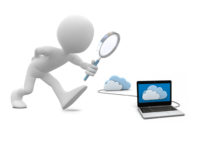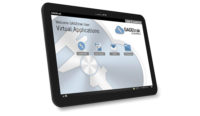Software & Analysis
Getting to the Core of Cloud Computing
Is calibration management making the move?

Some cloud-based calibration management software allows you to utilize local resources, such as calibration label printers and barcode scanners. Source: CyberMetrics Corp.

There are many good reasons to go with a cloud computing software application, but also some risks. Source: CyberMetrics Corp.




With all the major IT companies spending millions pushing their cloud products and services, one has to wonder, why all the promotion? Most of us have seen the television, magazine and Web ads from IBM, Microsoft, Oracle and others advertising this technology with vague concepts, claims and buzzwords. These ads probably leave some people wondering what cloud computing is, what the benefits are and how this technology will help their organizations.
What is Cloud Computing?
Cloud computing is no longer a cutting-edge technology. Most people already use cloud computing whether they realize it or not. If you use Internet search engines, online email software like Yahoo or Hotmail, social networking systems such as Facebook and Twitter or on-demand video streaming like Netflix or Vudu, then you’re already using cloud computing.
The term “cloud” is just a metaphor for the Internet which is typically drawn as a cloud shape on computer network diagrams. Cloud computing providers deliver various business software applications which are most often accessed from a Web browser. The main distinction of cloud vs. traditional computing is that the software, data and computer processing reside on the service providers’ servers.
In traditional software applications, the user needs to be concerned about the required operating system, hardware requirements such hard drive space, CPU speed and memory and database storage systems (SQL Server, Oracle, DB2, etc.). The cloud, however, shields users from the technical details, so they no longer have to have expertise in the technology that supports their software.
Cloud computing is a newer (and some would say better) delivery model for IT services and software. In business environments, much of the aim is toward software applications that require scalability and accessibility to support hundreds or even thousands of users located in multiple facilities. In consumer-based cloud systems such as Google or Facebook, they must support millions of concurrent users. Cloud computing is very similar to a public electric service—it can scale to accommodate whatever is needed and the consumer doesn’t need to know the technical details of the resources used to create the electricity or the delivery methods employed. Consumers just want their lights and air conditioning to work when they flick the switch.
Cloud Computing Heavy Hitters
Core business software such as ERP (enterprise resource planning) and CRM (customer relationship management) can have dozens or hundreds of users in just a medium-sized facility, so for them, cloud computing is of significant value. To install, manage and maintain desktop-based software for such a high number of users would be quite costly and time-consuming. As a result, there are many competitive cloud computing options available for this type of software.
In the business sector, software giants like IBM, Oracle and Microsoft all have cloud offerings; in consumer markets, companies like Google, Amazon and Facebook dominate in cloud computing (Facebook actually became a Fortune 500 company last year). Even retailers like Wal-Mart are participating by acquiring technology companies like Vudu for cloud-based video streaming. They know where this is trending.
Moving Calibrations to the Cloud
Quality management software is no exception in the ongoing trend to move business systems and software apps to the cloud.
In the field of quality assurance and control, there are some cloud and Web-based management systems for SPC, document control, FMEA and corrective actions, though the choices are still few at present.
Only a handful of companies offer calibration management software systems that can be run through a Web browser and there are fewer still that provide this software as a service (SaaS) through cloud computing. One of the reasons for the lack of options is the lack of demand. Regardless of facility size, there tends to be a relatively small number of calibration management software users—anywhere from one to around twenty, so it’s not too difficult or costly to set up and maintain traditional desktop software for so few users.
Even though cost efficiencies may not be realized for small groups of users, it’s a substantial benefit to be able to share cloud account access with management, auditors and even outside calibration service providers to access measurement data and calibration certificates. Additionally, the convenience and efficiency of accessing the software from any computer, receiving automatic updates with no IT involvement and accessing information in the field is invaluable.
In the past couple of years, many larger organizations with multiple facilities and higher numbers of users have completely shifted their calibration systems to the cloud. Because the provider handles everything from software installation to updates and database storage, an organization’s costs associated with traditional software licensing, support, upgrades, maintenance and IT hardware are minimized. By having both the software and the data hosted by the provider, their total cost of ownership is greatly reduced.
As the market learns more about the benefits of cloud computing, the demand for traditional desktop and on-premise server software will certainly lessen.
Pros
There are many good reasons to go with a cloud computing software application. Some of the top reasons are:
Agility
One of the most popular reasons for adopting the cloud is that it promotes organizational agility. The reasoning is that organizations can now do things they could never do before and can establish computing tasks much more quickly and with more flexibility.
Moving to a cloud service means that wherever there is an Internet IP connection, people all over the country and all over the world can be provided access to an organization’s business systems and data. In traditional premise-based software, employees and partners had to be on-premise at a limited number of locations. Cloud services are designed to be used from a distance, so a mobile workforce will have on-the-go access to the calibration system 24/7.
Organizations can also gain access to a much larger labor pool, be able to offer more flexible work hours to employees and even let them work from home or while traveling. New geographic markets can be serviced that were previously too expensive, complex or burdensome to attempt.
Cost Efficiency
The complex infrastructure of a cloud-based solution is shared among the multiple customers of a service provider, so each company only pays for what they need. Also, there are little or no maintenance costs, as most providers include software maintenance as part of subscription fees.
Fast Deployment
Basic cloud software and services can be ready to use in just a few hours or a few days. For more complex software and database solutions, cloud computing eliminates the hardware procurement and capital expenditures; it’s perfect for new facility start-ups, those with limited IT budgets and organizations without in-house IT expertise. For the management of multiple facilities, it’s even more compelling to go with a cloud solution. Additionally, providers constantly update their software offerings, adding new features and patches as soon as they become available; these updates reach the end user far more quickly than with traditional software.
Scalability
For a growing business or one with seasonal spikes, cloud computing allows for a quick scale-up because the systems are built to cope with sharp increases in workload and in the number of users. On the other hand, it’s just as easy to scale down and not pay for something that’s no longer needed.
Cons
Providers are well aware of the typical concerns associated with cloud computing and continue to find ways to reduce them and eliminate risk.
Expensive Customization
While traditional applications have many features to cope with specialized needs, customizing a cloud service typically costs more.
Usability
Some people are firmly tied to traditional software, reluctant to switch to plainer online applications that may not have all the UI features and functions that they are used to. Although providers are somewhat hampered by limitations of the browser, efforts are constantly being made to bring parity between traditional and cloud application software. One example is shifting some of the UI processing to the user’s local computer (client side) so the application is more responsive. The use of Asynchronous JavaScript and XML (AJAX) and other technologies improve usability and responsiveness and also provide a richer desktop-like experience to users of Web-based and cloud applications.
Connectivity
Users must have the proper Internet bandwidth and connection reliability in order to fully utilize a cloud-based system. Sometimes cloud services do fail and go down, but this is rare due to redundancy and failover systems.
Security
Security is a big issue and in some cases involves legal or regulatory compliance requirements for industries such as medical, pharmaceutical and defense manufacturing. Cloud software users need to know that their data will be safe and protected.
For business security, there is the concentration of corporate risk in one single place. If you’re running your CRM in the cloud, you certainly don’t want your competitors gaining access to your customer database. Likewise, ERP users would not want competitors gaining access to proprietary formulas, process setups and capacity information.
Providers of cloud services have multiple lines of redundancy, multiple layers of defense and multiple levels of security that a single company usually could not afford on its own.
While larger business software applications such as CRM and ERP have already moved to the cloud for reasons of business agility, cost efficiency, reduced maintenance costs, centralized management and easier deployment, smaller and more specialized software applications such as calibration management are also beginning to make the move for many of the same reasons.
If you are currently looking to upgrade or replace your current calibration system, it is suggested that you take a good look at cloud computing to see how it might benefit your organization.
|
TECH TIPS
|
Looking for a reprint of this article?
From high-res PDFs to custom plaques, order your copy today!












